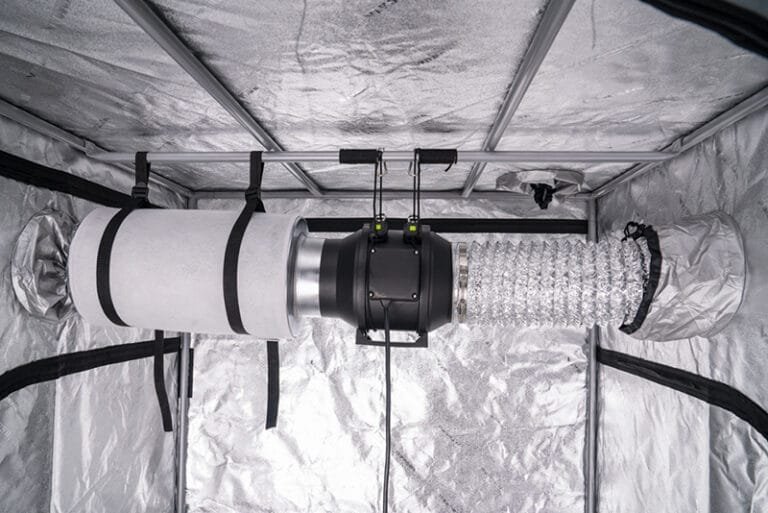Proper humidity levels serve as a crucial factor for successful indoor cannabis cultivation. The correct humidity levels affect your plant health and produce moldy buds regardless of whether you grow autoflowers or photoperiods. The following article presents simple methods to control humidity in grow tents at reasonable costs.
📊 Ideal Humidity Levels by Growth Stage
- Seedling stage: 65–70% RH
- Vegetative stage: 40–70% RH
- Flowering stage: 40–50% RH
- Late flowering (last 2 weeks): 35–45% RH
Chart showing recommended RH levels per growth stage
(Source: Royal Queen Seeds)
💨 Use an Exhaust Fan and Intake Fan Setup
Good airflow is your first line of defense. A powerful exhaust fan removes humid air, while a passive or active intake allows fresh air in. The addition of an oscillating fan enhances air circulation throughout the tent space.
✅The AC Infinity Cloudline T6 stands as a recommended product for hydroponic growers because it provides quiet operation and temperature and humidity control functions
🖼️ The setup illustration for a grow tent airflow system should be used as an example image.
🌬️ Use a Dehumidifier (or Humidifier)
The need for a dehumidifier becomes essential when your grow tent maintains RH levels above target during the late flowering period.
💡Tip: You should position your dehumidifier outside the tent when space is limited while using ducting to guide airflow into the tent.
The use of a humidifier becomes necessary for dry environments. The dehumidifier requires clean distilled water to prevent mineral deposits from forming.
🔗 Best Grow Tent Dehumidifiers for Cannabis
“Marijuana is not a drug… it’s an herb.”
– Tommy Chong
🧂 DIY Humidity Hacks That Work
Here are some budget-friendly humidity control tips:
- A quick method to boost humidity inside the tent involves hanging wet towels within its space.
- Use open water containers during the veg phase of your operation.
- A mixture of baking soda and rock salt placed in containers works as a moisture-absorbing solution during the flowering stage. Water collection in the tent must be avoided because it leads to mold growth
⚠️The article contains an example image showing the implementation of DIY humidity control systems through the use of salt bowls with towels.
🌡️ Monitor with Accuracy
Use a digital thermometer that comes with data logging capability and hygrometric functionality. Daily tracking of maximum and minimum RH levels should be your priority.
✅ Popular choice: Govee WiFi Hygrometer — real-time readings to your phone.
🏠 Control the Room Environment
The environmental conditions of the surrounding area affect the humidity levels that exist within the tent. The conditions of your closet or spare room require attention:
- The room should maintain proper ventilation.
- Use a room dehumidifier or AC if needed
- Close windows on humid days.
🧠 Pro Tip: Use a Humidity Controller
A humidity controller operates by automatically controlling fans and dehumidifiers through RH-based operations.
🔗 Inkbird IHC200 Humidity Controller — easy to use, plug-and-play.
🪴 Final Thoughts
Each growth stage requires proper humidity control to stop three major problems from occurring:
- Bud rot
- Powdery mildew
- Stunted growth
Controlling humidity requires finding a middle ground because excessive moisture leads to mold development while insufficient moisture harms plants. Follow these methods to establish a balanced grow tent environment which will result in both flavorful and healthy harvests.
Read More Article: Complete Indoor Cannabis Grow Setup on a Budget
